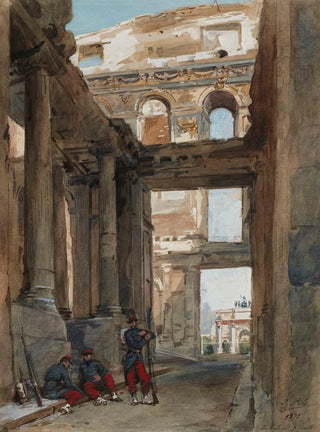Art print | Ruins of the Tuileries July 7, 1871 - Isidore Pils


View from behind

Frame (optional)
In the treasure trove of art history, certain works transcend their era to become poignant witnesses of crucial moments. "Ruins of the Tuileries 7 July 1871" by Isidore Pils is one of those creations that, through its depth and realism, evokes the tumult of a period marked by war and destruction. Painted the day after the Paris Commune, this piece does not merely depict a devastated landscape; it also embodies the collective memory of a nation in suffering and loss. Gazing upon this scene, the viewer is immediately transported to a wounded Paris, where the remnants of the Tuileries tell a story of vanished grandeur.
Style and uniqueness of the work
Isidore Pils's style is characterized by an academic rigor that harmoniously blends with romantic sensitivity. In "Ruins of the Tuileries," each brushstroke appears charged with emotion, each shade of color reflecting the prevailing melancholy. The artist excels in the art of light, creating striking contrasts between the shadows of the ruins and the luminous flashes of the sky. This play of light intensifies the dramatization of the scene, making the work both realistic and poetic. The composition, carefully orchestrated, guides the viewer’s eye through the debris, revealing details of a glorious past now in ruins. It is this ability to fuse the tragic and the sublime that gives the work its unique and timeless character.
The artist and his influence
Isidore Pils, a prominent figure of the 19th century, established himself as a preferred painter within the French school. Trained in the ateliers of the greatest, he developed a style that combines academic tradition with contemporary innovations. His engagement with historical and social subjects reflects a desire to resonate the voices of the past within his art. Pils also influenced a generation of painters, encouraging a more emotional and narrative approach to painting. Through his works, he manages to capture the very essence

Matte finish

View from behind

Frame (optional)
In the treasure trove of art history, certain works transcend their era to become poignant witnesses of crucial moments. "Ruins of the Tuileries 7 July 1871" by Isidore Pils is one of those creations that, through its depth and realism, evokes the tumult of a period marked by war and destruction. Painted the day after the Paris Commune, this piece does not merely depict a devastated landscape; it also embodies the collective memory of a nation in suffering and loss. Gazing upon this scene, the viewer is immediately transported to a wounded Paris, where the remnants of the Tuileries tell a story of vanished grandeur.
Style and uniqueness of the work
Isidore Pils's style is characterized by an academic rigor that harmoniously blends with romantic sensitivity. In "Ruins of the Tuileries," each brushstroke appears charged with emotion, each shade of color reflecting the prevailing melancholy. The artist excels in the art of light, creating striking contrasts between the shadows of the ruins and the luminous flashes of the sky. This play of light intensifies the dramatization of the scene, making the work both realistic and poetic. The composition, carefully orchestrated, guides the viewer’s eye through the debris, revealing details of a glorious past now in ruins. It is this ability to fuse the tragic and the sublime that gives the work its unique and timeless character.
The artist and his influence
Isidore Pils, a prominent figure of the 19th century, established himself as a preferred painter within the French school. Trained in the ateliers of the greatest, he developed a style that combines academic tradition with contemporary innovations. His engagement with historical and social subjects reflects a desire to resonate the voices of the past within his art. Pils also influenced a generation of painters, encouraging a more emotional and narrative approach to painting. Through his works, he manages to capture the very essence






